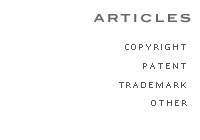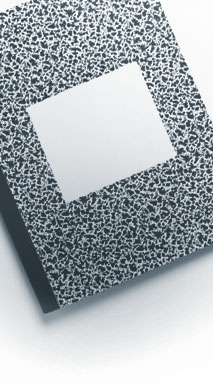

 |
||
 |
Dress Code PRINT Magazine November/December 1998 Frank J. Martinez, Esq. Every designer knows the essence of communication resides in the simplest of elements: type, color, line, texture, and shape. Together these elements create the total look and feel of a product, package, or design. In a world dominated by market motivation, good design creates market advantages. Increasingly, those who understand the power of design employ formal legal methods such as trademark, copyright, utility, and design patents as methods of protecting their competitive advantages. Within the legal community, such protection is collectively known as the doctrine of trade dress. The body of law relating to trade dress could be said to have formal and informal legal elements. The formal elements are those typically associated with the protection of intellectual property: trademark, copyright, patent, and design patent. The informal elements are less susceptible to definition, and as a result, Title 15 of the United States Code, Sections 1051-1127, were enacted. Known as the Lanham Act Section, Section 43(a), this federal law is intended to protect consumers and manufacturers against “the deceptive and misleading use of [trade]-marks in commerce … to protect against unfair competition … to prevent fraud and deception … by the use of reproductions, copies, counterfeits, colorable imitations of registered trademarks….” While such phrases have specific meaning within the legal community, they offer no guidance to the design community. For the designer, the issues relating to trade dress can be reduced to a single question: How well does a design communicate the identity, quality, and source of the goods or services in a manner that distinguishes them from competitors in the field? Typically, the courts think of trade dress as the total image or overall impression made upon consumers by the size, shape, color, color combinations, texture, and graphics used on a product, packaging for a product, container configuration, or services. At one time or another, the legal doctrine of the trade dress has been invoked to protect such well-known products as Brut cologne, Stolichnaya vodka, and Ferrari automobiles, and, in a case decided last April, even the fictional film character Godzilla. In Toho Co. v. William Morrow and Co., Godzilla was recognized as having a protectable trade dress. Even though Toho’s case relied primarily on an allegation of copyright infringement, the Court used classic trade dress language when granting Toho a preliminary injunction against the publisher William Morrow. In its decision, the Court noted that Toho’s “Godzilla has … developed a constant set of traits that distinguish him/her/it from other fictional characters. While Godzilla may have shifted from evil to good, there remains an underlying set of attributes that remain in every film. Godzilla is always a prehistoric, fire-breathing, gigantic dinosaur alive and well in the modern world.” Recently, the trade dress for Mattel’s Barbie doll was at issue when Mattel sought to stop the distribution of the song “Barbie Girl” by the Danish band Aqua. In this case, the use of color figured prominently. Here, both the CD and the group’s related “Barbie Girl” video were alleged to have created consumer confusion because they employed an overall pink-and-white color scheme reminiscent of the pink and white used in packaging and accessories for Mattel’s Barbie. While denying Mattel’s injunction on grounds related to a Copyright Fair Use defense, the Court nevertheless closely examined the roles of color packaging, packaging configuration, and type styles as they related to the trade dress of the respective goods. A designer who is presented with the opportunity to create packaging or a container is in an ideal position to maximize the likelihood of protection for the resulting trade dress. Courts will examine whether a package, label, or product configuration is unusual or striking enough in appearance that the design is conceptually separate from the product while functioning as an indicator of source. Stated another way, the design must be markedly unusual and different when compared to designs for similar products so as to become associated with the particular provider of the goods or services. A design that closely emulates its competitors isn’t likely to be considered a protectable trade dress. This is so even where the trade dress at issue is the configuration of the product itself. In the recently decided Leatherman Tool Group, Inc. v. Cooper Industries, Inc., the design for Leatherman’s popular all-in-one Pocket Survival Tool was allegedly copied by Cooper’s Crescent brad Tollzall tool. Rejecting Cooper’s functionality defense, the Court noted, “Defendant either knew or should have known that an unpatented, unregistered product may still be protectable under the law of trade dress.” Here, the Court found that Cooper’s willful infringement justified an amazing $4.5 million in punitive damages. From a purely legal perspective, a successful design is one where consumers attach significance to those features of the design that distinguish it from others in the field. In such cases, the trade dress is said to be either “inherently distinctive” or to have developed “secondary meaning.” An inherently distinctive trade dress or trademark is one where the design is so unique that it is capable of distinguishing the source of goods instantly. “Secondary meaning” is a term applied to trademarks or trade dress that consumers associate with a particular source or manufacturer because of consistent use and advertising and which consumers specifically choose because the product or service originates with a particular producer. This goal of consumer recognition isn’t easy to achieve. Indeed, as long ago as 1942, the Supreme Court recognized that “the protection of trademarks is the law’s recognition of the psychological function of symbols.” The same can easily be said of trade dress. While there are no specific rules to follow in achieving this goal, an organized and thoughtful approach to design that incorporates the design equities of a trademark or brand stands a good chance of being protectable. However, what is a designer to do when confronted by a project for a new product or service that has no brand identity to build on? Here are a few guidelines. Whenever possible, design so that the “totality” of the design works toward creating a protectable trade dress. In other words, it is the use of a consistent set of design elements for labeling, packaging, or container configuration in combination with a trademark that creates a protectable trade dress. The law recognizes that combining distinct elements such as words, names, symbols, color, color combinations, textures, shapes, and graphics can create trade dress rights. In addition, advertising that emphasizes the functional aspects of a design will almost always militate against trade dress protection. In particular, phrases such as “now in a new easy-to-use package,” “with a new easy-pour spout,” or “with a new easy-carry handle” would all weaken a trade dress using the advertised feature. A trade dress may not be protectable if there are facts which establish that alternative designs are not available to competitors. For example, if there is only one way to design the package or container, it means that the design flows directly from functional considerations and isn’t protectable. The design also won’t be protectable if it arises from economic concerns relating to simplicity or economy of manufacture. Protection won’t be extended if the resulting design or configuration gives one competitor an economic advantage over others simply because they were the first to exploit the most efficient design. Such monopolistic protection resides in the realm of patents and is the reward for invention and innovation. Also, any trade dress or trademark that is descriptive of the goods or services isn’t likely to be considered protectable. Finally, a trade dress that incorporates features that are commonly used in the particular industry won’t be protectable. Design, at its best, is an art. In the legal world, however, no attempt is made to define good or bad art, just as no attempt is made to define good or bad design. The law of trade dress reduces all design to the by-products of its impact, creating tests that reflect the indicia of commercial success. So, in its own obtuse way, the law recognizes and protects good design. Trade dress law provides no formula for design success. It merely distinguishes that which can be protected from that which cannot. In a perfect world, designers would work unfettered and uninfluenced. However, increased communication has presented them with a growing range of influences. The law of trade dress erects barriers to those who would appropriate another’s work and protects the commercial success that seems to follow good design.
Home Copyright Trademark Patent Litigation About Us ©2004 The Martinez Group PLLC |
 |